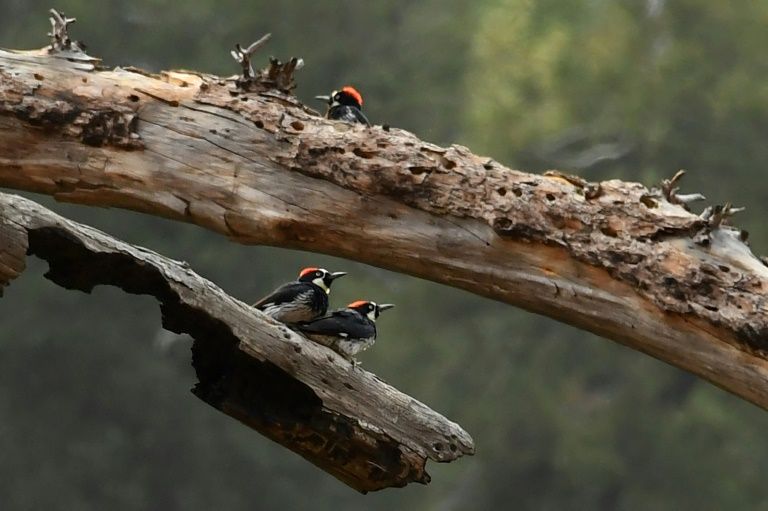Woodpeckers wage war over prized breeding sites
Washington (AFP) – Acorn woodpeckers wage battle royales that last days in order to win valuable territory vacated by deceased counterparts, according to a new study Tuesday that used radio tags to track the warring birds.
Researchers also found that spectators flew in from miles (kilometers) around to watch the fights, collecting valuable social information from the power struggles.
The paper was published in the journal Current Biology and led by Sahas Barve, a postdoctoral fellow at the Smithsonian National Museum of Natural History.
Scientists already knew these turf wars attracted 40 or more birds from different areas, but it was unclear precisely what was going on.
“We now know that these birds put in tremendous effort to win the power struggles,” he told AFP.
If you were to approach a big tree hosting a battle from far away, you would first hear a lot of acorn woodpeckers making angry calls and zapping around.
“When you get closer, you can see that there are a dozen or more coalitions of three or four birds fighting and posturing on branches,” he added.
“One group has to beat all the others to win a spot in the territory, which is really, really rare in animals.”
In order to make more sense of the chaotic scenes, the scientists placed miniaturized, solar-powered radio tags on the backs of 36 acorn woodpeckers in California using fanny-pack like harnesses.
These radio tags are more advanced than the previous generation of devices, which were bulkier and relied on batteries, constraining their life span.
The new tags feed information to receivers on the ground, allowing the researchers to track the birds almost in real time.
– Moving up in society –
The woodpeckers were fighting for control over “granaries” — large acorn storage structures consisting of acorns stuffed into thousands of individual holes in the bark.
The granaries are valuable mating sites, housing multiple male and female breeders and their offspring.
When a breeder dies, nearby groups of non-breeding birds form same-sex coalitions of either sisters or brothers to go and fight for the vacant spot.
If they are victorious, they can claim the site for themselves, which allows them to move up the social ladder and have their own offspring.
The radio tag data showed that some birds returned for several days to engage in up to 10 hours of hostile spread-wing displays, incessant calling, and intense fighting that was at times fatal.
“We didn’t think it could be that long because they have to be away from their home territory,” said Barve. “When do they eat? We still don’t know.”
The team had hypothesized that woodpeckers would fight hardest for territories closest to their current home, but found that in reality, more complex social forces were at play.
“These birds often wait for years, and when there’s the right time and they have the right coalition size, they’ll go and give it their all to win a really good territory,” said Barve.
The sophisticated social behavior was also seen in the fact that the battles attracted large crowds, some traveling as far as three kilometers to see the action.
“They are curious birds — just like humans watch important social events, they do that too,” said Barve.
The birds came for up to an hour a day to watch the fights, despite many already having granaries of their own.
The researchers inferred that the benefits of acquiring social information must outweigh the costs of leaving their homes unattended for so long.
Acorn woodpeckers live in tight social networks and know everyone’s place because of their frequent travels to other territories.
“If anything is disruptive to that, or if anything weird happens, they want to go check it out,” said Barve.
Disclaimer: Validity of the above story is for 7 Days from original date of publishing. Source: AFP.


